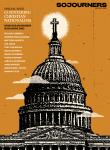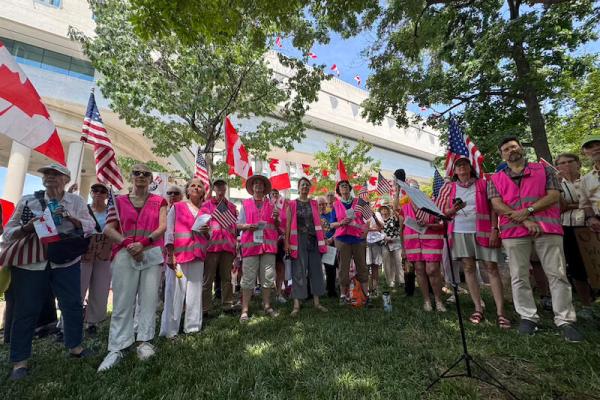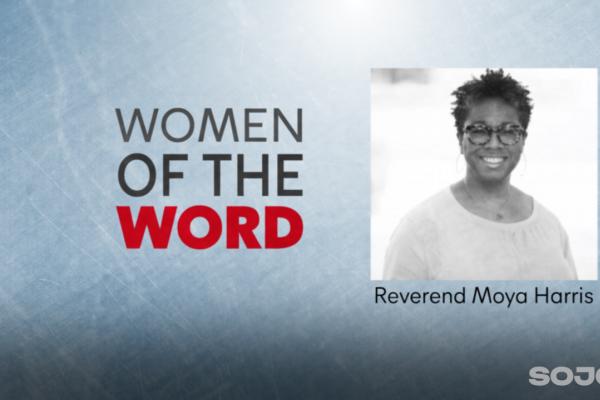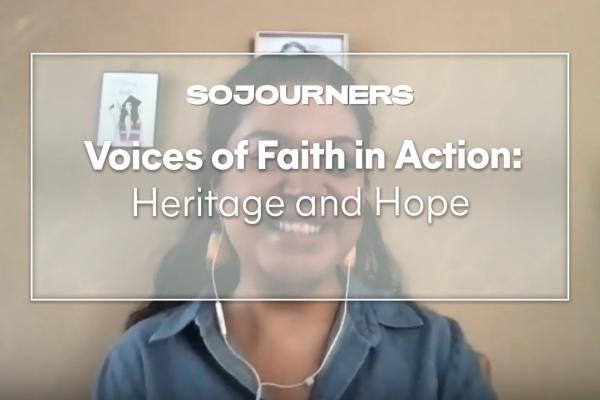THROUGHOUT THE HISTORY of North American Christianity, the church has vacillated in its view of the intersection of evangelism and social justice. For a significant portion of that history, the church has been a moral voice on behalf of the “least of these” and advocated for justice in the public realm. Many Catholics and other Christians have not wavered in this work.
Since early in the 20th century, however, U.S. evangelical Christians in particular have focused primarily on personal evangelism and separated it from the justice witness of the church in public life. One of the negative consequences of the divorce of evangelism from justice has been the inability of evangelicals to engage politics in a biblical manner. Because evangelicals have seen social justice as a “secular” activity, our understanding of how justice works in the public square has been shaped more by the secular political imagination than by a biblical political imagination.
In the absence of a political imagination rooted in Jesus’ gospel of sacrificial love and the prophetic tradition, dysfunctional expressions such as Christian nationalism, conflating faith with a specific party, and extreme polarization have emerged as the de facto position of much of the church in the political realm. The public sphere is captive to divisive and contentious rhetoric and characterized by a quest for power, and the desire to hold and wield that power over and against one’s political opponent. The goal of many Christians in U.S. politics has deteriorated into acquiring power rather than serving the common good.
Much of U.S. evangelicalism has seemingly fallen into this trap — in contrast to the historical call of the church to be an advocate for the voiceless and powerless. How would engagement in the public realm change if the political imagination of evangelicals were to shift from this grab for power toward the Jesus’ teaching to be servants of all? How can scripture and biblical examples offer insight in this fraught political season?
A return to the biblical text can help us better understand the foundations of the church and, therefore, the full role of the church in the public arena. Our calling as the church is not only to save individual lives from a “wrecked vessel” but also to honor the imago dei in every individual and offer hope by caring for the very least of these — by being salt and light in the world.
Historical context of Pentecost
THE CHRISTIAN CELEBRATION of Pentecost, which is often understood as the birth of the church, directly connects to the Jewish holiday Shavuot (the Festival of Weeks celebrated 50 days after Passover). The gospel narrative emerges from the prophetic narrative of the Old Testament and the Jewish festival of Pentecost provides social and theological context for the birth of the New Testament church. The Jewish festival is a time of renewing and affirming the covenant between God and God’s people, and so the birth of the new covenant community is in the context of the existing covenant with Yahweh’s people in the Old Testament.
The church, therefore, continues the high calling of representing God’s presence and witness in the world. As in the Old Testament covenant community, the church is an expression of God’s shalom (the fullness and fulfilment of God’s will and work in the world). The people of God in both the old and new covenant reveal the heart of God in acts of mercy, grace, and justice.
In Acts 2, during the Festival of Weeks, the Holy Spirit falls upon the disciples of Jesus and the church is born (Acts 2:1-4). The presence of the Holy Spirit inaugurates a new era in history, but it is marked by its connection to the older covenant. The Holy Spirit compels a fearful community struggling for their identity to embrace their identity as God’s people upon whom the Spirit of God has fallen.
Bringing the gospel to life
ONE OF THE external expressions of the church emboldened and empowered by the Holy Spirit is the apostle Peter preaching the good news to a large crowd. “Peter stood up with the eleven, raised his voice and addressed the crowd [offering an empowered proclamation of the gospel message]. ... When the people heard this, they were cut to the heart” (Acts 2:14, 37). Many in the crowd respond to Peter’s preaching with repentance and baptism, and the church experiences its first growth spurt. “Those who accepted his message were baptized, and about three thousand were added to their number that day” (Acts 2:41).
Most American interpretations of Acts 2 emphasize the powerful preaching and public proclamation of Peter’s sermon (Acts 2:14-40), which is assumed to be the primary impetus for the growth of the church in Acts 2:41 and 47. In most English translations, Acts 2:41 (“Those who accepted his message were baptized, and about three thousand were added to their number that day”) is marked off as the culmination of Peter’s sermon and not as part of the following section describing the community life of the church. This reflects assumptions about the importance of preaching and verbal proclamation to evangelism and church growth.
But I would assert that Acts 2:41 serves as a bridge between Peter’s sermon and the life of the church as described in Acts 2:42-47. What if the growth of the church described in Acts 2:41 belongs structurally to the last section of Acts 2 rather than the first section? If we examine Acts 2:41-47 as one unit, a structure emerges for these verses that points to another explanation for the growth of the church. Acts 2:41 and 47 serve as framing verses for what occurs between Acts 2:42 and 46.
The structure of this passage, therefore, follows the chiastic structure so commonly found in Greek literature. In chiastic structures a series of ideas move toward a central statement and then repeat in reverse order. Acts 2:41-47 seems to develop in this manner:
- A Numerical growth of the church (Acts 2:41)
- B Characteristics of church life (Acts 2:42-43)
- Fellowship (teaching, breaking bread, prayer)
- Outsiders are amazed
- Self-sacrificial life of the church (Acts 2:44-45)
- B' Characteristics of church life (Acts 2:46-47)
- Fellowship (meeting in the temple, breaking bread, praise)
- Outsiders are amazed
- B Characteristics of church life (Acts 2:42-43)
- A' Numerical growth of the church (Acts 2:47b)
In using the chiastic structure, Luke may be pointing to a different interpretation of the growth of the church in the first century. The center of this chiastic structure, Acts 2:44-45, depicts the self-sacrificial life of the church, in which the believers hold “all things in common” and “sell their possessions and goods and distribute the proceeds to all, as any had need.” These center verses become the focus of how the outer statements, which describe the church adding to its number, come to pass. So, instead of seeing evangelism and church growth as the effect of Peter’s verbal proclamation and preaching of the gospel, we could instead see evangelism and church growth as a product of how effectively the self-sacrificial life of the church demonstrates the gospel.
Have we overemphasized personalized, verbal proclamation while ignoring the public manifestation of the gospel through racial reconciliation, social service, social action, and justice? Have we sought the growth and increase of the church without considering self-sacrificial living as the necessary value to be exhibited for the church to grow?
God’s call for justice is made evident throughout scripture. While specific expressions of evangelicalism have eschewed justice as a biblical call, the scriptures themselves testify to a God who calls the community toward a shalom that requires justice. The movement of God, therefore, is evident in the evangelistic efforts of the church that seeks the salvation of individual souls through the proclamation of the gospel, but also demonstrates God’s justice in a world longing for the shalom of God’s kingdom.
The birth of the church in Acts 2 reveals a community committed to proclaiming the gospel while also sharing the compassion, mercy, and justice of the gospel through the church’s self-sacrificial example. At the founding of the church, justice as witness is demonstrated. Evangelism and justice go hand in hand.
A different power dynamic
BUT THERE IS an additional element of the Acts 2 Pentecost story that cannot be ignored. The value system of God’s people in Acts 2 differs from the value system of the world in a clear and direct way. The church does not seek more power within their own community nor in the outside world. The same Holy Spirit that empowered the once-denying-of-Jesus apostle Peter to boldly, publicly proclaim the good news also empowers the people of the church to do something that may go against their very nature. Instead of seeking their own betterment or using the power of the purse to gain authority or control over others, God’s people lay down their power (their material possessions and wealth) so that those who were without could be lifted. The true power of the Holy Spirit is to yield power and thus demonstrate the gospel in unexpected ways, such as by raising up the powerless and voiceless.
In the same way, could the 21st century evangelical church in the United States heed the call to not pursue its own agenda of power and greatness, but rather learn to be the servant of all? Could the church lay down the expressions of power (institutional, political, and material) — or at least stop seeking to grab more of it — for the voiceless to be more clearly heard? Could we defend the widows, the orphans, and the immigrants among us for the sake of the gospel?
In this contentious election season, U.S. evangelicals could provide the profound example of laying down power rather than seeking more of it. What if the evangelical vote demonstrated a concern for the interests of the very least of these (the refugee, the other, the poor, the outcast) rather than simply our own benefit? Our political engagement could be used not for our own material gain and for the sake of increased political power, but for the sake of the gospel, which is good news for the poor. Our desire to make the church great again could be infused with the sense of learning and seeking to be a servant of all.

Got something to say about what you're reading? We value your feedback!







